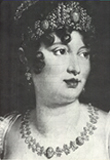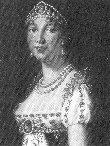|
|||||||||||||||||||||
|
|||||||
| It's the end of a gelid fall, filtered of fogs and flurries; the "Tuilleries" immovable awaits the Event. It's the legendary December 2, 1804. In Notre Dame, at the presence of Pius VII, Napoleon self-crowned himself emperor of France. And with him his wife Giuseppina: the multitude of relatives by now of blue blood, the new blazoned hierarchy, and the new politic elite are his wings. The High parade brings back into vogue, with a stroke of magic wand, the French jewelry. Some recoveries signs have been notice already in the 1779 when Napoleon was console. Decoration and attitudes imposed by the Terror were already slowly fading away. Away the hairstyle "a la victime", with the hairs high on the neck and the curls overthrown on the forehead as a memory of the executions; away the red ribbon around the naked neck of the ladies; away the don't precious metal jewels with macabre representation of guillotine and the revolutionary symbols from the tricolor enamel cabochon to the cockades; away the wood crucifixes priest's prerogative. Proponent of those sinister jewels were the same aristocrats, the survivors, so relaxed with the contemporary history to give parties "a la victime" to which is allowed to go only who can demonstrated to have a guillotined relative. With the finances healed, and the power reinforced, it's natural get back into pomp, as much as Napoleon himself love jewels and that Giuseppina adores them with extravagance and insolent greed. Most of the goldsmiths of Louis XVI court come out of the shadows, bringing back that century XVIIIth destined to the comebacks, so much is the nostalgia of "grandeur" that France has inside. But the neoclassic style in the apparel leaves still little space to the jewel. In high favors are the "sautoires", neck and waist chains that alternate gold plates carved with enamels, linked to other chains, all complicated as a labyrinth. The new fashion has no limits in the drop earring, in the rings wore in every finger, even in the feet. Madame Tallien shows up at the "Tuileries", supported by a colored page, with six sapphire rings in the feet, eight in the hands, two gold bracelets in the ankles, eighteen in the arms, a band in the forehead full of rubies. It's an irresistible comeback for the precious gems fashion, and for the magic diamonds; showing them off doesn't damage but promotes. Napoleon gasps the possession of the Crown's jewels that were disperse in 1792. He seizures every thing that remains of that fortune initiated by Frank starting by the emeralds and pearls and he makes the "parures" with it for the crowing. Among the Napoleon's most appreciated goldsmiths, Etienne Nitot gets to do the gold and precious gems tiara that will be donated to Pius VII. Already in 1797 Napoleon is able to get possession of the Regent, a 140 carats diamond, owned by Philippe d'Orleans who disappeared during the French Revolution. Napoleon will pawn it to fund the Italian campaign and then, redeemed, he has it mounted in the royal sword. The Giuseppina's diadem is a blazing jubilation of 1040 diamonds of a total of 250 carats. If the diamonds satisfy, the cameos are in vogue. They decorate "parures", buckles, belts; Pauline Borghese blazons them framing the cameos with pure diamonds mounted as "pave". The artist is Robert Lefebvre. When the son is born, the king of Rome, Napoleon covers of jewels his second wife, Maria Luisa D'Austria. Among the gifs, a fabulous diamond necklace of 275 carats. Most of these jewels will go along with the empress in her escape from Paris towards her new destiny as Parma's duchess. But the most loved gem by Napoleon remains a brilliant of 34 carats, the Napoléon, which he has it mounted on the sword for the wedding with Giuseppina. It follows him in the glorious battles, it's his talisman. He loses it in Waterloo, along with the Empire. Disappeared Napoleon, after a few years of austerity, the goldsmith's art returns to shine. The iron jewels become topical again, art born in Germany and that Napoleon, conquered Berlin, stole sacking methods and formulas of the Royal Berlin Factory frenchifing the style. With the Restoration it gets discovered the charm of the ancient roman jewelry, but it's a slow process. Louis XVIII, eager of rigor and overburdened with his weak finances, doesn't show appreciation towards the minor or major arts. However he has modify what remains of Napoleon's treasury by the jeweler Bapst, going back to the styles of XVIIIth century, like to say that Napoleon and his time never existed. But there is always, in a court, who adores the luxurious jewel, like the Barry's duchess who transmitted to all the aristocrats the diamond fever and dragged them in what is her personal battle against the jewel's mechanical pressing, technique born in England, but already used in continent: the automatism of the semi finished, favourite by an expansion market even if not always elite, that presses against the artistic goldsmith. In 1824 ascends the throne Carl X. It appends then that for the baptism of the Bordeaux's duke, the architect Hittorf decorates Paris cathedral inspired by the gothic style. Explodes the passion for the "decor à la cathédrale". The Barry's duchess backs it up choosing the jewels and the table objects in this style. It's famous her tea set ordered to Fauconnier and sculptured by Barye. Master by excellence in this gothic vision is Fromen-Meurice that prefers draw the jewels then manually make them. From his inspiration are born picturesque lived scenes permeate of fairy tale. Friend of Victor Hugo, he is believed the new Benvenuto Cellini by Balzac and By Eugène Sue to whom provides jewels and knick-knacks. The Revolution of 1848 shuts up, for a while, inspirations and desires. With the Second Empire and with Napoleon III, elected in 1852, returns the taste for the precious, the costly, and the signed. Diamonds and precious gems are back again. All France awakes and it exalts in the taste of empress Eugenia who has the passion for pearls, diamonds, for the rich creative fantasy of the XVIIIth century, of Louis XVI style, of the pompous court of Napoleon. All of the Crown's jewels are reconstructed to the resemblance of those of Maria Antoinette. Louis Franicoise Cartier is her favorite supplier. But in 1870 Napoleon III is deposed, the Third Republic lays an oblivion veil on luxury and ostentation. The minor jewelry looks for new forms sacking the industrial revolution's symbols. The feminine taste, fed by the journals of the period, asks and waits continually for news. The industry answers right away, with an express and convenient goldsmith production, generous, but often uncoordinated. The passion for the luxury it extends; the artisan activity it transforms; associations artistic-commercial are born, predecessors of the contemporary big Goldsmith's Houses. |
|||||||
|
|||||||
|
|||||||
|
|||||||


